| 5 – 4/7: Feresti – Dej, 147km |
Visualizza balcani5 in una mappa di dimensioni maggiori

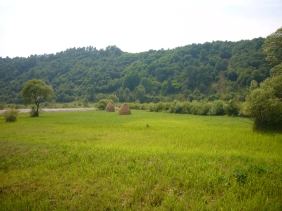
Maramures
Dalla pensiunea mi dirigo verso Baia Mare. La strada inizia subito a salire leggermente, mi aspetta il passo Gutai a quasi 1000m di quota (sono a circa 300 all’inizio della tappa). La salita è molto lunga ma regolare e non molto dura, intorno al 5%, si snoda con larghi tornanti attraverso paesaggi molto belli, in una valle verdissima accanto ad un torrente. La mattinata è iniziata ancora sotto la pioggia ma più avanti il tempo migliorerà anche se ci sarà qualche scroscio pure dopo aver scollinato il passo. La discesa è veloce, la strada buona e si può andare forte. Si arriva di volata a Baia Sprie e Baia Mare. La prima è una città in una zona mineraria, che a me è apparsa veramente desolante; non meglio la seconda. A Baia Mare decido di non seguire l’itinerario pianificato che prevedeva di passare per Targu Lapus. La scelta è dettata dal timore di trovare qualche strada in pessimo stato. Proseguo quindi sulla strada 1C che è sicuramente ben asfaltata. I primi 20km sono in pianura e li impiegherò in una penosa lotta contro il vento, poi la strada lascia la pianura e si inoltra in una bella zona collinare, verde e tranquilla. Lungo il percorso ci sono diverse strutture alberghiere dove è possibile pernottare. Le colline sono belle ma sarà un continuo saliscendi, la strada è ancora lunga (82km da Baia Mare a Dej), e la salita è a tratti dura. Dopo molti km finalmente la discesa mi farà recuperare un po’ la media ma per Dej manca ancora molto e gli ultimi km sono una sofferenza di saliscendi e sobbalzi per l’asfalto irregolare. A Dej trovo un albergo diciamo “spartano” ma non ho tanta voglia di cercare altro e me lo faccio andare bene.
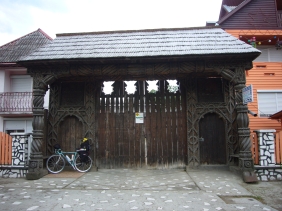
![]() Leaving pensiunea I head towards Baia Mare. The road starts slightlyascending, Gutai pass is the next step at almost 1000m above sea level (Feresti is about 300m). The ascent is very long but regular, not very hard, about 5%, with many large curves in a very beautiful countriside, a green valley along a small river. The morning started again under the rain but later thw weather will get better though some shower after pass. Descent is very fast, the road is good. You’ll get quickly Baia Sprie and Baia Mare. The first one is a city in a mining area, it looked to me really drab. Not better the secondo one. In Baia Mare I decide not to follow the planned route through Targu Lapus, being afraid of finding some very bad road, then I proceed along 1C main road that is for sure in a good state. The first 20km are flat and I’ll spend them fighting against the wind, then the road leaves the flat land and passes through a very beautiful hilly and green landscape, very quite. Along this road there are some places to sleep (hotel/pensiune). Hills are very beautiful but continuously up-and-down, the road is still long (82km from BM to Dej) and ascent is sometimes quite hard. After many kms eventually the descent will help to recover average speed but Dej is still rather far and last kms are just suffering, up-and-down and bumping asphalt. In Dej I find a quite bad hotel but I have no will to find something else.
Leaving pensiunea I head towards Baia Mare. The road starts slightlyascending, Gutai pass is the next step at almost 1000m above sea level (Feresti is about 300m). The ascent is very long but regular, not very hard, about 5%, with many large curves in a very beautiful countriside, a green valley along a small river. The morning started again under the rain but later thw weather will get better though some shower after pass. Descent is very fast, the road is good. You’ll get quickly Baia Sprie and Baia Mare. The first one is a city in a mining area, it looked to me really drab. Not better the secondo one. In Baia Mare I decide not to follow the planned route through Targu Lapus, being afraid of finding some very bad road, then I proceed along 1C main road that is for sure in a good state. The first 20km are flat and I’ll spend them fighting against the wind, then the road leaves the flat land and passes through a very beautiful hilly and green landscape, very quite. Along this road there are some places to sleep (hotel/pensiune). Hills are very beautiful but continuously up-and-down, the road is still long (82km from BM to Dej) and ascent is sometimes quite hard. After many kms eventually the descent will help to recover average speed but Dej is still rather far and last kms are just suffering, up-and-down and bumping asphalt. In Dej I find a quite bad hotel but I have no will to find something else.
| 6 – 5/7: Dej – Targu Mures (in treno/by train) |
Nella notte un vero e proprio uragano ha colpito la zona dove mi trovo e gran parte della Romania, dal Maramures al Mar Nero. Al mattino vedo in tv gli effetti violenti su zone che avevo lasciato e dove mi dovrei recare. Piove forte e fa molto freddo, per cui decido di trasferirmi in treno a Targu Mures, come da itinerario. Il trasporto della bici sui treni romeni è un incubo. Porte strette e altissime, banchine piccolissime tra i binari e condizioni generali abbastanza disastrate. Non è chiaro se il trasporto bici sia consentito o meno, se sia a pagamento e quanto possa costare. Il primo controllore dice qualcosa ma poi lascia perdere quando tento di rispondere in inglese o tedesco. Il secondo, un donna, mi chiede addirittura 200 Lei (circa 66euro) per il biglietto della bici. Il mio biglietto è costato 30 Lei (10 euro). Alla mia faccia che esprime il concetto “200 non te li do neanche se piangi in turco” abbassa la richiesta a 100. Alla fine le darò 10 Lei (3 euro) solo per chiudere la discussione. In sostanza ci ha provato; se non mi fossi fatto i conti al volo o avessi temuto problemi (se mi avesse costretto a scendere dal treno alla prima stazione ?), mi avrebbe fregato. Ovviamente non ho ricevuto nessuna controparte per quei soldi, nè un biglietto nè una ricevuto o un qualsiasi pezzo di carta. Il mistero sulle tariffe rimane, anche perchè il terzo controllore mi dice che si paga ma non mi sa dire quanto. Fortunatamente parla inglese, gli spiego che già ho pagato per la bici, evidentemente comprende la situazione e chiacchieriamo brevemente sul mio viaggio. In ogni caso dubito fortemente che quei 10 lei siano andati nelle casse delle CFR e credo che, semplicemente, il trasporto bici non sia previsto. Arrivo a Targu Mures, nel pomeriggio smette di piovere, il tempo sembra in miglioramento. La pensione è carina e la signora molto gentile. Riesco a riposare un po’ nel pomeriggio in un lettone con enorme coperta di pelo di pecora.
![]() During the night a sort of hurricane struck the Dej area and other places in Romania, from Maramures to Black Sea. During breakfast watching tv I see the effects on places that I had left and the area where I should go today. It rains a lot and, above all, it’s very cold, so I decide to transfer by train in Turgu Mures. Loading a bycicle on Romanian trains is a nightmare. Doors are narrow and very high on the ground level, small alleyway between tracks and quite bad general condition. It is not clear if transporting a bike is allowed, if it is free or not and how mucht it may cost. First ticket controller tells me something but gives up when I try to reply in English or German. The second one, a woman, asks me 200 lei (about 66 eur) as bycicle ticket. My ticket costed 30 lei (10 eur). My face express a concept like “you can even cry in Turkish, I’ll never give you such money”, so the request lowers to 100 lei. At the end of the discussion I’ll give her 10 lei just to close the conversation but the mistery is not solved because a third ticket controller will tell me that I should pay but he is not able to tell me how much. Luckily he speaks English so conversation turns on my journey and ticket cost is forgotten. Anyway I doubt that such 10 lei have gone into CFR cash and I think that, simply, bike transport is not regulated. The train reachs Turgu Mures, in the afternoon stops raining and weather seems to be get better. Pension is nice, I can have a rest in a big bed with a huge cover made of sheep wool.
During the night a sort of hurricane struck the Dej area and other places in Romania, from Maramures to Black Sea. During breakfast watching tv I see the effects on places that I had left and the area where I should go today. It rains a lot and, above all, it’s very cold, so I decide to transfer by train in Turgu Mures. Loading a bycicle on Romanian trains is a nightmare. Doors are narrow and very high on the ground level, small alleyway between tracks and quite bad general condition. It is not clear if transporting a bike is allowed, if it is free or not and how mucht it may cost. First ticket controller tells me something but gives up when I try to reply in English or German. The second one, a woman, asks me 200 lei (about 66 eur) as bycicle ticket. My ticket costed 30 lei (10 eur). My face express a concept like “you can even cry in Turkish, I’ll never give you such money”, so the request lowers to 100 lei. At the end of the discussion I’ll give her 10 lei just to close the conversation but the mistery is not solved because a third ticket controller will tell me that I should pay but he is not able to tell me how much. Luckily he speaks English so conversation turns on my journey and ticket cost is forgotten. Anyway I doubt that such 10 lei have gone into CFR cash and I think that, simply, bike transport is not regulated. The train reachs Turgu Mures, in the afternoon stops raining and weather seems to be get better. Pension is nice, I can have a rest in a big bed with a huge cover made of sheep wool.
| 7 – 6/7: Targu Mures – Barkut, 94km |
Visualizza balcani7 in una mappa di dimensioni maggiori
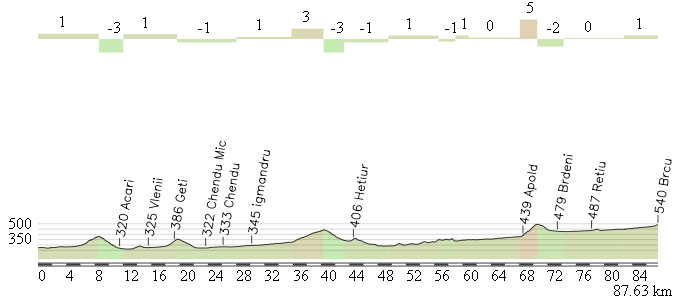
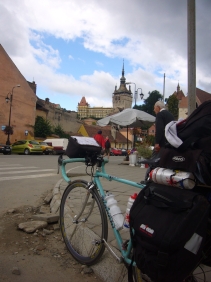
Sighisoara
La giornata inizia bene, la strada 18 da Targu Mures verso Sighisoara è larga e perfetta. Il paesaggio collinare ha un po’ di saliscendi faticosi ma il paesaggio ripaga. La seconda metà è molto sinuosa e piacevole. A Sighisoara breve passaggio nel centro storico e spuntino. Da Sighisoara per Brasov vi sono due possibili itinerari: si può continuare la strada 18, circa 115km con un passo a 620m, oppure passare per Fagaras con un tratto di circa 50km su strade minori e il resto sulla strada 1. Io avevo scelto questo itinerario sia perchè è leggermente più corto, sia perchè all’Infopoint di Sighisoara mi avevano consigliato di fare quel percorso in quanto (a detta della signorina con cui avevo parlato) è molto più bello e meno trafficato. Benissimo, riprendo a pedalare in direzione Saes, Apold. Il primo tratto mantiene le promesse: 25-30km veramente molto belli in mezzo alla campagna, traffico scarsissimo, asfalto buono. Da Bradeni in poi la strada principale prosegue verso Agnita. Sulle mappe è difficile capire quale è “la strada principale” e quale “un’altra strada”, sembrano tutte uguali. Purtroppo proseguendo verso Fagaras la strada diventa rapidamente una pietraia impraticabile resa ancora più tragica dal fango creatosi con le piogge del giorno prima. Saranno 15km di pena a 5-10km/h, con il nulla più assoluto tutto attorno, con il rischio di forare o di rompere qualcosa ad ogni metro.

I miei freni posteriori dopo la strada per Barkut – My rear brakes after the road to Barkut
Unico conforto la certezza di non essermi perso – ogni tanto ho incontrato qualche cartello che confermava la giusta direzione verso Fagaras. Il primo villaggio che si incontra è Barkut, poche case attorno ad una strada che per 500m sembra migliorare. Incontro un ragazzo seduto sul bordo della strada, gli chiedo in inglese come è la strada nel seguito e lui mi rassicura, da lì in poi la strada è buona. Niente di più falso, fatte poche centinaia di metri dopo l’uscita dal villaggio mi rendo conto che ricomincia un sentiero di pietre nel nulla. Sono stanco, più mentalmente che fisicamente, ho già fatto più di 90km, non è tardi (circa le 14). Decido di tornare nel villaggio e chiedere se è possibile raggiungere Fagaras con qualche altro mezzo (avevo visto un bus parcheggiato vicino alle case). Il ragazzo di prima non c’è più (fuggito temendo la mia reazione ?), incontro una anziana donna che ovviamente parla solo rumeno e cerco – inutilmente – di farmi capire in qualche modo. Nel frattempo arriva una ragazza che parla inglese e la situazione si risolve. Mi offrirà di pernottare nella casa della famiglia. Grosse possibilità di arrivare a Fagaras in altro modo non sembrano essercene, almeno non in giornata, ma so che al mattino dopo, a mente fresca, ci posso arrivare anche da solo, fosse pure necessario farsi 25km di pietraia a piedi. La famiglia mi accoglie in modo molto cordiale, mi danno da mangiare e mi fanno riposare un po’ su un divano.
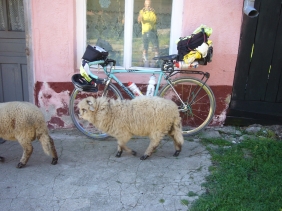
Nel giardino della casa di Barkut
Trascorrerò il resto del pomeriggio e la serata in compagnia della famiglia, mi faranno vedere gli animali della stalla, cenerò assieme a loro con i prodotti della terra e mi intratterrò fino a tardi nella vita sociale di Barkut davanti al piccolo negozio dove lavora la ragazza che mi ha ospitato chiacchierando con lei e con altri e dove farò conoscenza con due amici che organizzeranno un trasbordo a Brasov con un furgone per il giorno dopo. Ho assaggiato la proverbiale ospitalità rumena di cui avevo letto prima di partire. Non sono sicuro che nel “mondo occidentale” avrei trovato tanta disponibilità e sarò sempre grato a quella famiglia rumena che, come nella migliore tradizione dei grandi viaggiatori, ha rifocillato e ospitato il viandante sconosciuto facendolo sentire a casa propria. Il mattino dopo, con calma, si parte per Brasov su un furgone scassatissimo percorrendo una strada ancora più scassata. I km di pietraia saranno ancora 6 o 7 almeno e dopo ci saranno ancora diversi km di strada molto brutta. Solo in prossimità di Fagaras ritorna l’asfalto e fino a Brasov la strada è regolare. Il giovane rumeno che mi accompagna parla tedesco in quanto ha vissuto e lavorato per molti anni in Germania. Mi spiega che ad un certo punto ha deciso di tornare in Romania perchè lì ha una libertà che in Germania non aveva. Vive facendo trasporti con il furgone e un piccolo camion, porta attrezzature, trattori e cose del genere tra la Romania e la Germania. E’ difficile pensare di tornare a vivere in un posto in mezzo al nulla, con strade inesistenti e dove le case non hanno neanche l’acqua corrente. Se la fa evidentemente ha i suoi buoni motivi e tutto sommato certe assurdità della vita nelle nostre città mi fanno pensare che non abbia tutti i torti.
![]() The day starts fine, road 18 from Targu Mures to Sighisoara is wide and and perfect. Landscape is hilly, some up-and-down quite hard, but the view is great. The second half is very pleasant. In Sighisoara a short break in city center to have some food and give a look around. From Sighisoara to Brasov there are two possible routes: you can continue on road 18, about 115km and a pass at 620m, or passing through Fagaras, about 50km on minor roads and the rest on road 1. I had chosen this route because it is slightly shorter, also at Sighisoara Infopoint I had been adviced to follow such route because it is much more beautiful and less traffic. Ok, let’s start cycling heading to Saes, Apold. The first part is great: 25-30km really beautiful, in the middle of countryside, almost no traffic, good asphalt. From Bradeni the main road continues to Agnita. On the map is difficult to understant which is “the main road” and wich “another other road”, they look like all the same. Unfortunately going to Fagaras the road gets quickly an impossible track ofstones and dirt. They will be 15km of pain at 5-10km/h, in the middle of nowhere. The only sure thing was the fact I didnt get lost (sometimes I could see arrows to Fagaras). The first village is Barkut, few houses along a road that seems to get better. I meet a guy sit on the border of the road and ask him how is the road. He says it’s ok, from now on the road is fine. Unfortunately this is not the truth, few hundreds meters after the village the road is again only stones. I’m tired, more mentally than physically, I already covered 90km and actually it is not very late (about 2pm). I decide to come back to the village to ask if it is possible to reach Fagaras some way (I had seen a bus parked near the houses). The guy met before is not there anymore (escaped afraid of my reaction ?), I see an old woman who obviusly speaks Romanian only and I try to let me understand someway. Meanwhile a young girl who speaks English join us and the situation gets solved. She offers me to sleep in her family’s house. There are not much possibility to get Fagaras with other means, at least not today, but I know that tomorrow, after resting the night, I can get the city, even if I should walk 25km. The family welcomes me very friendly, they give me food and let me have a rest a little time on a sofa. I’ll spend the rest of the day with the family, they will show me the home’s animals (sheeps, a cow), I will have dinner with then with countryside products (eggs, cartofi nature, tomatoes, milk) and will stay until night enjoying the Barkut’s social life at the little shop where the girl works, talking with her and with other people and where I meet two friends of her who will arrange to bring me to Brasov by car the next morning. In the morning I carry the bike on the car and go to Brasov. The road is only stones for at lest 6-7km then some kind of very bad asphalt will take us to Fagaras. Only near the city the road is again good until Brasov. The young rumenian guy who drives the car speaks German and tells me that after several years spent in Germany working there he decided to come back in Barkut because he has there a freedom he could not have in Germany. He lives trasporting goods and other things using the car and a small lorry between Romania and Germany. It’s difficult to think one can decide to live in a place in the middle of nowhere, with no roads and where houses do not even have the water taps. Probably he has good reasons to do that (sometimes some nonsenses of western life makes me think he might be not so wrong).
The day starts fine, road 18 from Targu Mures to Sighisoara is wide and and perfect. Landscape is hilly, some up-and-down quite hard, but the view is great. The second half is very pleasant. In Sighisoara a short break in city center to have some food and give a look around. From Sighisoara to Brasov there are two possible routes: you can continue on road 18, about 115km and a pass at 620m, or passing through Fagaras, about 50km on minor roads and the rest on road 1. I had chosen this route because it is slightly shorter, also at Sighisoara Infopoint I had been adviced to follow such route because it is much more beautiful and less traffic. Ok, let’s start cycling heading to Saes, Apold. The first part is great: 25-30km really beautiful, in the middle of countryside, almost no traffic, good asphalt. From Bradeni the main road continues to Agnita. On the map is difficult to understant which is “the main road” and wich “another other road”, they look like all the same. Unfortunately going to Fagaras the road gets quickly an impossible track ofstones and dirt. They will be 15km of pain at 5-10km/h, in the middle of nowhere. The only sure thing was the fact I didnt get lost (sometimes I could see arrows to Fagaras). The first village is Barkut, few houses along a road that seems to get better. I meet a guy sit on the border of the road and ask him how is the road. He says it’s ok, from now on the road is fine. Unfortunately this is not the truth, few hundreds meters after the village the road is again only stones. I’m tired, more mentally than physically, I already covered 90km and actually it is not very late (about 2pm). I decide to come back to the village to ask if it is possible to reach Fagaras some way (I had seen a bus parked near the houses). The guy met before is not there anymore (escaped afraid of my reaction ?), I see an old woman who obviusly speaks Romanian only and I try to let me understand someway. Meanwhile a young girl who speaks English join us and the situation gets solved. She offers me to sleep in her family’s house. There are not much possibility to get Fagaras with other means, at least not today, but I know that tomorrow, after resting the night, I can get the city, even if I should walk 25km. The family welcomes me very friendly, they give me food and let me have a rest a little time on a sofa. I’ll spend the rest of the day with the family, they will show me the home’s animals (sheeps, a cow), I will have dinner with then with countryside products (eggs, cartofi nature, tomatoes, milk) and will stay until night enjoying the Barkut’s social life at the little shop where the girl works, talking with her and with other people and where I meet two friends of her who will arrange to bring me to Brasov by car the next morning. In the morning I carry the bike on the car and go to Brasov. The road is only stones for at lest 6-7km then some kind of very bad asphalt will take us to Fagaras. Only near the city the road is again good until Brasov. The young rumenian guy who drives the car speaks German and tells me that after several years spent in Germany working there he decided to come back in Barkut because he has there a freedom he could not have in Germany. He lives trasporting goods and other things using the car and a small lorry between Romania and Germany. It’s difficult to think one can decide to live in a place in the middle of nowhere, with no roads and where houses do not even have the water taps. Probably he has good reasons to do that (sometimes some nonsenses of western life makes me think he might be not so wrong).
| 8 – 7/7: Barkut – Brasov (in auto/by car) |
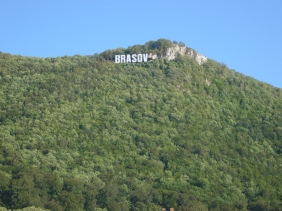
Brasov come Hollywood
Brasov è una bella cittadina storica ai piedi dei Carpazi, meta di turismo locale e internazionale. Durante la passeggiata nel centro ho incontrato ben due gruppi di cicloturisti, a dimostrazione che non sono io l’unico folle che vaga per la Romania in bicicletta (a dire il vero sono l’unico da solo). Il primo gruppo è formato da quattro ragazzi francesi, il secondo è di polacchi. Tutti si lamentano delle strade !
Il traffico in città è caotico (a parte nell’isola pedonale) e c’è un gran viavai di invitati, spose e sposi in giro per le vie cittadine.
![]() Brasov is a beautiful hystoric place near the Carpathian mountains, visited by local and international tourism. During a walk in city center I met two groups of cycloturists (so I am not the only one who rides through Romania by bycicle – actually I am the only one alone). The first group is made of four French young people, the second one of Polish. Everybody complains for roads! Traffic in city center is cahotic (apart walking area) and there is a lot of invitees, brides and gooms around.
Brasov is a beautiful hystoric place near the Carpathian mountains, visited by local and international tourism. During a walk in city center I met two groups of cycloturists (so I am not the only one who rides through Romania by bycicle – actually I am the only one alone). The first group is made of four French young people, the second one of Polish. Everybody complains for roads! Traffic in city center is cahotic (apart walking area) and there is a lot of invitees, brides and gooms around.